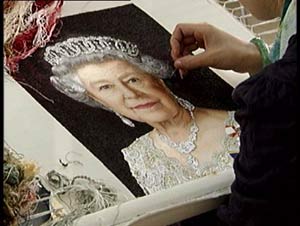
Goodness, we found the Queen in Suzhou! Sometimes we think paintings are so realistic they look like photographs, but imagine this embroidery. It looks virtually like the real thing, especially the eyes, all done with fine work of a needle.
Yin: How long have you worked on this piece?
Artist: About 6 months.
Yin: How long will it take to finish?
Artist: 8 months
Yin: The thinnest string is used for which part?
Artist: It should be the string in the eyes because of the slight sudden changes in the color. It captures the change in emotion and there is a wide variation in color. To make the thinnest string, we take one string and divide it into 64 parts. Embroidery is like painting. The artist's brush is the needle and string is our like ink.
This may just look like a normal piece of string, thin long, but to make the embroidery of the thinnest part, the eyes of the portrait, you must divide this string into 64 parts. I'm going to get to work.
Suzhou embroidery is known for its detailed and intricate images, but to accomplish all of this, you need the raw materials. So start off, I had to divide the string, which is much harder than it appears.
I got it. So tiring on the eyes. Now I know I could never do this as a profession. I'll stick to my day job.

Suzhou embroidery is one of the oldest embroidery techniques in the world with origins dating back to over 2,000 years ago. Delicate images, fine needlework, and sometimes translucent cloth make it world-renowned. The work is done with brightly colored silk threads that are divided again and again until they are barely visible to the eye.
Next we head to Tongli Town, 23km north of Suzhou City, about an hour drive outside of Shanghai. The area is divided into seven islands by 15 rivers and connected into a whole by 49 ancient bridges.

